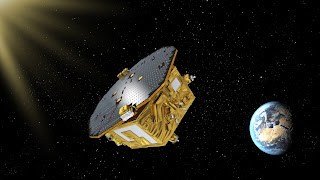 |
| An artist's rendering of LISA Pathfinder on its way to Earth-sun L1. Credits: ESA/C. Carreau |
Topics: Astrophysics, Black Holes, General Relativity, Gravitational Waves, NASA
LISA Pathfinder (Laser Interferometer Space Antenna), a mission led by the European Space Agency (ESA) with contributions from NASA, has successfully tested a key technology needed to build a space-based observatory for detecting gravitational waves. These tiny ripples in the fabric of space, predicted by Albert Einstein a century ago, were first seen last year by the ground-based Laser Interferometer Gravitational-Wave Observatory (LIGO).
Seismic, thermal, and other noise sources limit LIGO to higher-frequency gravitational waves around 100 cycles per second (hertz). But finding signals from more exotic events, such as mergers of supermassive black holes in colliding galaxies, requires the ability to see frequencies at 1 hertz or less, a sensitivity level only possible from space.
A space-based observatory would work by tracking test masses that move only under the influence of gravity. Each spacecraft would gently fly around its test masses without disturbing them, a process called drag-free flight. The primary goal of ESA's LISA Pathfinder mission is to test current technology by flying around an identical pair of 1.8-inch (46 millimeter) cubes made of a gold-platinum alloy, a material chosen for its high density and insensitivity to magnetic fields.
NASA:
LISA Pathfinder Mission Paves Way for Space-based Detection of Gravitational Waves
Comments